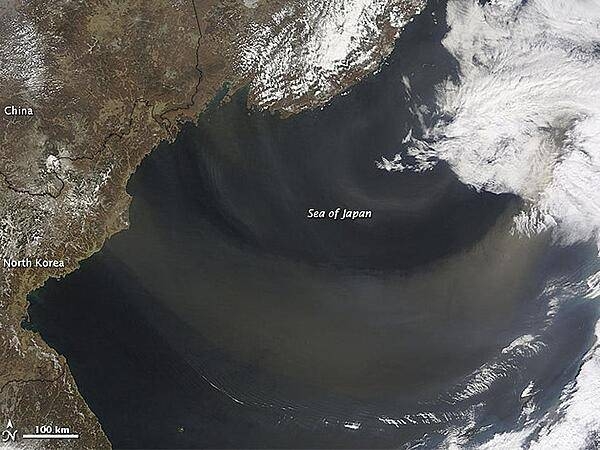Pacific Ocean
Photos
41 Photos
Per Page:
Filter Categories
All
Filters
A combination of datasets from different satellites makes possible this beautiful 'Blue Marble' view of the Pacific Ocean. The string of islands across the top are the Aleutian chain of Alaska; the Hawaiian islands appear along the bottom. Image courtesy of NASA/Goddard Space Flight Center Scientific Visualization Studio.

A view of Southern China and the Gulf of Tonkin. At the center-right of the image, circled in a black outline, is the island of Hong Kong. Hong Kong sits on the South China Sea, which is mostly under cloud cover in this image. West of the South China Sea is the island of Hainan, seen at bottom-center, which separates the sea from the Gulf of Tonkin to the west. In this image, the Gulf of Tonkin is saturated with what seems to be a mixture of sediment and phytoplankton. Photo courtesy of NASA.

A dust plume arose over Inner Mongolia and on April 9, 2012, began its eastward journey over the Sea of Japan. New research shows that dust accounts for most of the 64 million tons of foreign aerosol imports that arrive in the air over North America each year. Credit: NASA Earth Observatory/Jeff Schmaltz.

With the Seward Peninsula of Alaska to the east, and Chukotskiy Poluostrov of Siberia to the west, the Bering Strait separates the United States and the Russian Federation by only 90 km (55 mi). It is named for Danish explorer Vitus Bering, who spotted the Alaskan mainland in 1741 while leading an expedition of Russian sailors. The boundary between the US and Russia lies between Big and Little Diomede Islands, which are visible in the middle of the Bering Strait. At the bottom of this image is St. Lawrence Island. Situated in the Bering Sea, it is part of Alaska. Image courtesy of NASA.

A view of two of the Mariana Islands as seen from the space shuttle - Saipan (to the north) and Tinian. Image courtesy of NASA.

The largest of the three Volcano Islands, Iwo Jima is seen here from the north. The island is about 8 km (5 mi) long and 4 km (2.5 mi) wide, and covers an area of 21 sq km (8 sq mi). Mount Suribachi (167 m; 546 ft high), on the south side of the island, is an extinct volcano. Iwo Jima was the scene of one of the bloodiest battles in the Pacific Theater of World War II. Image courtesy of NASA.

Considered by many as one of the natural wonders of the world, the island of Bora-Bora is a single island surrounded by an extensive coral reef and a beautiful blue lagoon captured in the center of this low-oblique photograph. The coral reef north of Bora-Bora is Tupai Atoll. The two islands southeast of Bora-Bora - Tahaa (northern island) and Raiatea (larger southern island) - are encircled by a single coral reef system. Image courtesy of NASA.

The tropical island of Moorea as viewed from the International Space Station. The barrier reefs surrounding the island create zones of shallow, tranquil light blue waters. Image courtesy of NASA.

Easter Island, one of the most remote locations on Earth, is more than 3,200 km (2,000 mi) from the closest populations on Tahiti or Chile. Less than 25 km (15 mi) long, the island is dominated by volcanic landforms, including the large crater Rana Kao at the southwest end of the island and a line of cinder cones that stretch north from the central mountain. A final feature (difficult to see) is the very long runway (Chile's longest) near Rana Kao. The airport serves as an emergency space shuttle landing site. Image courtesy of NASA.

The two westernmost islands of the Galapagos archipelago. The largest of the group, Isabela, stretches across most of the frame. It was created from the merger of six shield volcanoes, several of which are visible in this view. The northernmost and highest, Volcano Wolf (1,707 m or 5,600 ft), lies directly on the equator. The smaller island of Fernandina displays a single volcanic cone. Image courtesy of NASA.

Millennium Island - known as Caroline Island prior to 2000 - is located at the southern end of the Line Islands, which make up the western portion of Kiribati. Uninhabited Millennium Island is formed from a number of smaller islets built on coral reefs. The reefs grew around a now-submerged volcanic peak, leaving a ring of coral around an inner lagoon. The shallow lagoon waters are a lighter blue than the deeper surrounding ocean water; tan linear "fingers" within the lagoon are the tops of corals. The two largest islets are Nake Islet (on the north) and South Islet. Image courtesy of NASA.

Kiritimati Island (formerly Christmas Island), the largest atoll in the Pacific Ocean, is the centerpiece of this low-oblique, northeast-looking photo. The atoll covers 606 sq km (234 sq mi), of which 243 sq km (94 sq mi) are land. The island was discovered by Captain James Cook in 1777. The majority of the island's inhabitants work on coconut plantations and in copra production. The island's major airbase is on the northeast side of the island. Nuclear tests were conducted on Kiritimati Island by the British in 1957 and 1958 and by the United States in 1962. Image courtesy of NASA.

Page 01 of 04